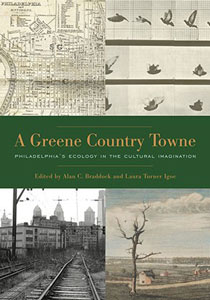Professor’s new book examines Philadelphia ecology through art and literature
In his previous teaching position at Temple University, Alan Braddock had a direct connection to Philadelphia. His interest in artistic expressions of the city’s environmental history led him to publish a book on the subject.
Braddock is the Ralph H. Wark Associate Professor of Art History & American Studies at William & Mary. He co-edited, co-wrote the introduction and wrote an essay for A Greene Country Towne: Philadelphia’s Ecology in the Cultural Imagination, which was recently published by the Penn State University Press.
Currently on sabbatical as the Barron Visiting Professor in the Environment and Humanities at Princeton, Braddock worked on this book project with former Temple doctoral student Laura Turner Igoe, now the Maher Curatorial Fellow of American Art at the Harvard Art Museums. Braddock describes their book as “an environmental history of Philadelphia from the point of view of the arts.”
How did you come up with the idea for the book?
The idea for the book originated several years ago while I was teaching at Temple University in Philadelphia, where I became interested in exploring the environmental history of the city from an interdisciplinary perspective. Lately there have been a number of books in urban environmental history, some about Philadelphia and some about other cities. It’s become a sort of genre of scholarly work — environmental histories of cities. But there hadn’t been one that focused on the arts, literature and material ecology of Philadelphia. That was my idea here, to provide an environmental history of Philadelphia from the point of view of the arts (including literature and architecture) with a special emphasis on the vital materiality of the city.
In other words, how have artists, writers, architects and other creative people over time imagined the ecology of Philadelphia as a living, material thing?
Did you make a conscious decision to focus on materials rather than people?
The purpose was really to produce a broader environmental history of the city that encompassed both human and nonhuman agents. It was a conscious decision to push this genre of urban environmental history in a new direction. Most books in this genre are very anthropocentric and managerial in their emphasis on human science and/or industry and how these affect the environment.
This book is different because it concentrates on art, the materials of art and the material experiences of everyday life as part of a more complex community of humans and nonhumans. It gives the materials themselves special attention as important agents in constructing art and environmental history.
How did you select the pieces that are included, and are they original or previously published?
There could have been many papers on various pertinent topics. The book doesn’t try to offer a comprehensive history of Philadelphia from this point of view.
What it tries to do instead is offer a new model of interpretation, a new way of approaching environmental history.
So at first glance, it may look like a selective assortment of studies. But each of the authors addresses a topic very important to the history of Philadelphia, approaching this in a new way. Topics include some major figures in art and literature, but they are examined from unusual perspectives.
For example, my essay is on Thomas Eakins, an artist famous for depicting human beings, but I discuss his fascination with nonhuman animals. In her essay on Charles Willson Peale, an important Philadelphia artist of the early national period, Laura studies his scientific experiments in what he called “fuel economy.” Another essay, by John Ott, examines the photographs of Eadweard Muybridge , which are among the most celebrated pictures ever taken in the city. Like Eakins, Muybridge is typically viewed in humanistic terms, but John’s essay relates his work to contemporary veterinary science in Philadelphia.

Other essays use similarly unusual perspectives to examine equally important or representative topics, including Native American material culture and perceptions of place, Walt Whitman’s interest in agriculture, W.E.B. Du Bois’ sociological study of African- Americans and their living conditions in the city, and recent projects in art and architecture that reimagine Philadelphia’s industrial history.
All the essays de-center human beings without eliminating them (which would be anti-ecological). In my view, if we’re going to be good environmentalists we don’t want to make human either control the entire story or simply disappear. We ought to recognize that humans are part of the world that we live in.
By opening our eyes to other beings and things in our world, including nonhuman animals and the materials around us, perhaps we can better find a way to coexistent with them.
In the most basic way, we wanted this unusual history of the city of Philadelphia to be more environmentally sensitive on multiple scales.
Can you talk about the research involved?
Almost all of the material in the book is new and original to this book. Even though I published a book on Eakins a few years ago, my essay here explores new material on the artist’s menagerie of pets and the culture of zoological gardens in the 19th century. The essays by Laura Igoe on Peale, Nate Gabriel on Fairmount Park, John Ott on Muybridge, Maria Farland on Whitman, Scott Hicks on Du Bois, Steve Nepa on Stephen Starr’s restaurants and Sue Ann Prince on a contemporary art installation by Winifred Lutz are all new. In two cases, we published revised versions of existing essays.
One of these was by Amy Menzer, a historian of urban planning. Her piece examines a large, public exhibition on urban planning held in a department store in Philadelphia during the 1940s. She showed how environmentally-minded urban planners after World War II were already imagining what we now call “new urbanism,” or the return of people from the suburbs to the city. The other revised essay, by Mary Unger, discusses a famous 19th-century Gothic novel about Philadelphia by George Lippard titled The Quaker City, which describes the city as a disorderly labyrinth of corruption. Both articles really deserved to have more attention drawn to them, so we asked the authors to edit and update them for our book.
What do you hope will be interesting for readers?
I think that the most interesting thing about this book is that it brings art and literature into the story of urban environmental history.
What is our most important takeaway?
No city is just the product of human beings. A city consists of a complex community of humans and other animals, environmental forces and materials. By understanding and appreciating this larger community, we have a fuller appreciation for the richness of urban existence. Art and literature can help foster such understanding and appreciation.
 Skip to main content
Skip to main content

